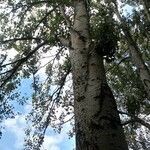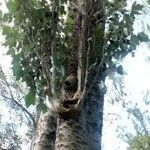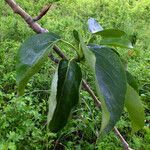Tree, 6-20 m high, terminal buds present; winter buds with several unequal outer scales; suckering freely. Leaves dark green and shiny above, grey-or white-woolly to green and smooth beneath; triangular or ovate, dentate. Inflorescences pendulous, odourless catkins, appearing before leaves. Flowers unisexual, anemophilous; borne in axil of a serrate or laciniate bract; perianth reduced to a cup-like disc. Male flowers reddish, with 4-30 or more stamens; filaments free; anthers 2-thecous, oblong to ovate, red. Female flowers none. Flowering time Sept.-Nov. Fruit none.




